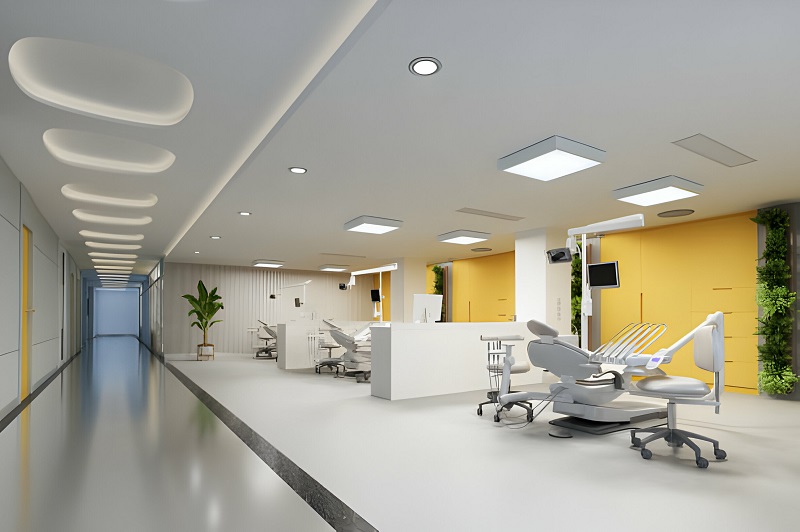Is your medical centre efficiently designed to enhance the joy and ease of carrying out day-to-day tasks? Are your spaces built to cultivate positive human experiences? How does the layout of your clinic impact your patients and staff's well-being and interaction? These are the critical questions that shaping the context of today's blog post—medical fitouts.
We're taking a deep dive into the planning and implementation of medical fitouts. Because, behind the caring health professional and the efficient receptionist, is a well-organised, thoughtfully designed, and carefully curated space that allows staff to carry out their tasks effectively and patients to feel at ease.
So, whether you're a budding clinic owner or an experienced medical professional looking to revamp your space, buckle up! We're about to embark on an extensive guide on successfully creating medical fitouts that significantly improve the functionality, aesthetics, and overall experience in your medical centre.
 |
| Medical Fitouts |
Why Are Successful Medical Fitouts Important?
Medical fitouts involve more than just ensuring there’s enough room for equipment and patients. Proper medical fitout design can affect your clinic's overall functionality, staff efficiency, and patient satisfaction rates.
A well-designed medical fitout can help enhance patient flow, reducing patient waiting times and increasing operational efficiency. Moreover, aesthetically pleasing and comfortable environments can help improve patient satisfaction and perception of your practice.
Hence, successful medical fitouts are not merely a tangential concern. They are an undeniably integral component that can help your clinic improve its services, raise its reputation, and ultimately bring in more clients and revenue.
What Elements Should Be Considered in Medical Fitouts?
Planning for a successful medical fitout involves considering several key factors. Location, for instance, is vital. It is crucial to analyse the layout and size of your clinic to ensure maximum efficiency. Planning should also include considerations for flexibility in spaces, to accommodate future growth and advancements in technology.
Understanding your demographic is equally essential when planning your medical fitouts. Patients from different age groups and backgrounds may have varying needs in terms of accessibility and comfort, which should be accommodated in your design.
Lastly, don't overlook the importance of aesthetics tempered by functionality. Using durable but appealing materials, furnishing the space effectively, and implementing suitable colour schemes play crucial roles in creating an environment conducive to healing.
When Should You Plan and Implement Medical Fitouts?
You should start planning your medical fitouts as early as possible and keep revising your design over time. This essentially means that if you’re just about to start your practice or looking to revamp your clinic, now is the perfect time to start.
Implementing medical fitouts is a calculated process. Make sure to consider both short-term and long-term goals in the design. The last thing you want is to go through the painstaking renovation process, only to find your design obsolete after a few years.
Planning and implementing your medical fitout design well in advance ultimately gives you the advantage of a well-thought-out, coherent design with fewer chances of needing drastic changes down the line.
 |
| Medical Fitout Design |
Who Is Involved in Planning and Implementing Medical Fitouts?
A successful medical fitout is rarely a one-man job. It involves a team of experts, including architects, interior designers, and contractors who will help bring your vision to life. Having a dedicated design team will ensure you achieve a space that is functional, aesthetically pleasing, and built to last.
Additionally, consultation with your staff is crucial. Their input, given that they are the ones who will be interacting with the space daily, can provide invaluable insights into what works and what doesn't for your medical fit out.
Pros and Cons of Implementing Medical Fitouts
Implementing successful medical fit-outs has several advantages. It significantly improves the functionality of your clinic, aids in staff efficiency, and enhances patient satisfaction. A well-planned medical fitout can also future-proof your clinic, accommodating growth and advancements in technology.
However, there are also potential setbacks. The process can be time-consuming and might necessitate clinic downtime. Budget constraints can also pose challenges. And, without careful planning and execution, you may end up with design flaws that could have been avoided.
Tips for Successful Medical Fitouts
Here are a few nuggets of wisdom for successful medical fit-outs: Consult experts, involve staff in the planning process, consider your demographic in the design, allow for flexibility in spaces, and, importantly, balance aesthetics with functionality.
Conclusion:
The planning and implementation of successful medical fit-outs might seem an overwhelming task, yet the rewards are ample. With well-thought-out medical fit-outs, you're not just creating an efficient workspace for your staff but also a therapeutic environment for your patients. Through careful planning, rigorous implementation, and thoughtful considerations of your needs, along with those of your patients and staff, you can create a medical fitout that enhances operations, boosts satisfaction, and ultimately, contributes to the healing process.
So, stay focused, keep your goals clear, and see your vision come to reality in the form of a comprehensive, well-structured, and successful medical fitout.






No comments:
Post a Comment